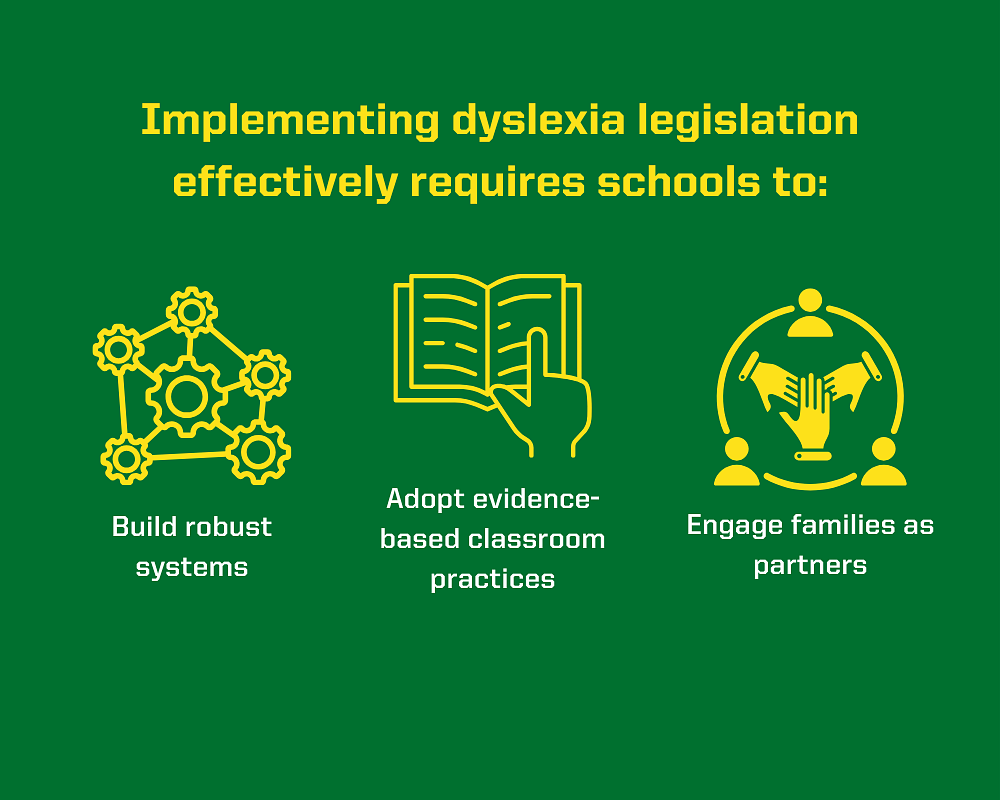By Victoria Mulkern, Doctoral Student, Lana Edwards Santoro, Director, National Center on Improving Literacy (NCIL), Boston University
Over the past decade, an increasing number of state legislatures across the United States have recognized the importance of codifying school-based protections for students with, or at-risk for, dyslexia. Since 2015, over 40 states have passed laws with sections/provisions on dyslexia, such as universal screening, structured literacy, and teacher training. These laws have often been aligned with, or have been a portion of, broader legislative initiatives like ‘Science of Reading’ and/or ‘Grade 3 Promotion’ laws. For instance, Missouri’s Chapter 167.950 emphasizes early screening and intervention, while Michigan’s two new 2024 laws (SB 567 & SB 568) integrate dyslexia provisions with broader tiered literacy improvement efforts. This legislative momentum reflects a commitment nationwide toward identifying and supporting students with dyslexia.
How can school leaders build on the legislative momentum? Here, we describe strategies for creating school-level structures, implementing effective classroom practices, and engaging families as partners in students’ learning and development. By framing these supports and strategies within an Multi-Tiered Systems of Support (MTSS) framework, these strategies can be envisioned to support students’ development across numerous contexts.
Building a Strong MTSS Framework to Support Interventions for Students with or ‘At-Risk’ for Dyslexia
Multi-Tiered Systems of Supports (MTSS) is a proactive framework for school improvement and equitable student outcomes that provides tiered systems of support to students. Implementing and sustaining a strong MTSS at the school and district levels is foundational to dyslexia laws, as the framework provides a tiered structure for screening, intervention, and progress monitoring of students in a proactive and preventative manner. Effective MTSS implementation requires clear alignment with state legislative mandates. For example, Tennessee’s HB 2616 specifies early screening and intervention as part of the state’s tiered framework for instruction and intervention. Schools should:
- Establish Clear Protocols: Define processes for universal screening, progress monitoring, and tiered intervention. Protocols must align with legislative requirements to ensure timely identification and instructional support for students with dyslexia.
- Allocate Resources Strategically: Deploy literacy coaches, interventionists, and reading specialists. Transparent criteria for tier movement, based on students’ response to interventions, promote equity.
- Use Data for Continuous Improvement: Regularly analyze screening and intervention data. Michigan’s laws, for instance, emphasize the use of multiple layers of evidence-based assessments to support data-based instruction at all tiers of an MTSS structure.

Effective Screening Practices for Early Identification of Dyslexia
Early screening is a cornerstone of dyslexia legislation, as seen in Mississippi’s HB 950, which mandates dyslexia screening for students in the Spring of Kindergarten and the Fall of 1st Grade in skills such as phonological awareness, letter-sound knowledge, decoding, and rapid naming. Some key practices of implementing universal screening for dyslexia on a school level include:
- Implement High-Quality Tools: Use validated screening tools to assess foundational literacy skills associated with risk for dyslexia. An increasing number of states, including the District of Columbia, require schools and districts to select an approved screening tool from a state list.
- Provide Comprehensive Training on Screeners: Train educators to administer, collect data, and interpret screenings results effectively. The training should also include information about the purpose of screeners and how screening assessments fit within an MTSS framework.
- Engage Families: Transparent communication about screening results fosters trust and aligns with legislative requirements, such as those in New Hampshire’s Section 200:59 (Screening and Intervention for Dyslexia and Related Disorders).
Evidence-Based Classroom Practices and Accommodations
Many of the new laws emphasize evidence-based practices such as explicit, systematic instruction in the teaching of foundational reading skills (i.e. phonemic awareness and phonics). Classroom practices should:
- Implement Evidence-Based Methods: States such as Indiana (IGA 20-18-2-3.5), which requires educators to implement evidence-based instruction and intervention for students identified as at-risk on the screener. Evidence-based practices include the teaching of foundational reading skills in an explicit, systematic, and multisensory manner.
- Provide Professional Development on Dyslexia and Evidence-Based Practices: Legislation in states like Iowa requires all PK-5 educators to complete ‘Dyslexia Overview’ modules. Schools should expand on this required training to provide in-house professional development on how to intensify evidence-based literacy practices for all learners, especially those with or at-risk for dyslexia.
- Support Diverse Learners: Integrate accommodations and assistive technology such as audiobooks, text-to-speech, and speech-to-text tools to promote the principles of Universal Design for Learning for all students in the classroom.
Engaging Families as Partners in Dyslexia Support
Family engagement is another hallmark in the recent wave of dyslexia legislation, which represents an increased understanding of the critical role caregivers play in supporting students with dyslexia. For example, West Virginia’s screening provisions (HB 3035) mandate schools to provide families with timely communication and access to resources to use at home with students. Schools can:
- Adopt Culturally Responsive Communication: Provide updates on screening, intervention plans, and progress toward reading proficiency in accessible formats for all caregivers (i.e. digital and print, translated materials, use of cultural brokers/interpreters, etc.).
- Offer Workshops and Resources: Host sessions on dyslexia awareness, structured literacy practices, and home-based support strategies. Partnering with community-based organizations can amplify these efforts.
- Foster Collaboration: Encourage families to participate in decision-making processes for interventions and accommodations, ensuring alignment with legislative requirements.
Implementing dyslexia legislation effectively requires schools to build robust systems, adopt evidence-based classroom practices, and engage families as partners. By aligning these efforts with legislative mandates, schools can create supportive, equitable environments for students with dyslexia. These practices should be viewed as dynamic, informed by data, and supported by ongoing professional learning and collaboration with families to meet the needs of all learners.
HEDCO Institute Blog 19 - March 27, 2025
Explore more:



